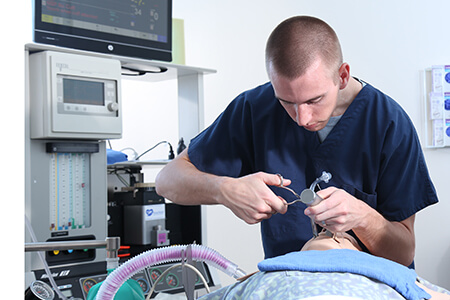Texas Wesleyan prepares to welcome its first cohort of eDNAP students

105 future CRNAs are preparing to make history this fall as the first cohort of Texas Wesleyan University’s new Entry-Level Doctor of Nurse Anesthesia Practice (eDNAP) program.
The program will bring a new emphasis to blending science foundations, anesthesiology implications and simulation labs to face-to-face campus-based learning. Students will spend 16 months in anesthesia foundation courses followed by a 20-month residency.
“We are very excited. We’ll get to know students better. They will get to know each other better,” Terri Kane, DNAP, CRNA, associate director of the eDNAP program, said. “We believe we’re going to have even greater opportunities for innovative teaching.”
Some of that innovative teaching includes access to anatomy software and hardware and smaller student to faculty ratios in the simulation lab, where students have the opportunity to practice life-saving skills in a life-like pre-clinical residency setting.
“All of our students will now have the opportunity to receive a coordinated curriculum that is complemented by access to high-quality simulation experiences, which gives them greater confidence and experience going into their residency,” Kane said.
An exhaustive search through decades of data went into developing the eDNAP curriculum. Faculty and staff looked back through board certification exam pass rates and student evaluation feedback among other data to determine what to consider in developing the program. But one strong factor was the vision of the faculty, staff and student input.
“I think most important was the desire on the part of the faculty and staff to not be the biggest program, but to be the best,” Kane said. “We asked ourselves ‘When starting a new program, if we can do anything we want to do, what do we want to do?’ That’s when we realized that we’re not locked into any one type of historical format.”
The new eDNAP program could not come at a better time. Kane says that the population of not just Americans but nurse anesthetist professionals themselves are getting older, with half of CRNAs estimated to be arriving at retirement age in the next 10 years. That means there is an urgent need to develop the next generation of anesthesia providers.
“Our vision is to educate and graduate stellar nurse anesthetists,” Dion Gabaldon, DHA, CRNA, eDNAP Program Director, said. “Developing a Texas Wesleyan University nurse anesthesia graduate to be a clinician and scholar is our goal. It’s what our patients deserve.”
Texas Wesleyan’s graduate programs of nurse anesthesia is the largest in the country with 20 primary clinical sites in 9 states. Check out more about Texas Wesleyan’s eDNAP program.







